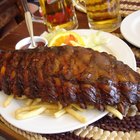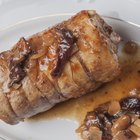bhofack2/iStock/GettyImages
Sliced bacon comes from a slab of pork belly, but a slab of pork belly doesn't bacon make. In other words, sliced bacon and slab bacon are the same thing, but slab bacon tends to taste better and command a higher price. To the bacon layperson, the only difference between the two is slicing. But to the connoisseur, the differences start with the pigs themselves.
Heritage Breed Vs. Common Pigs
Like humans, pigs have different body types. And like us, it's not always the pig's fault – blame it on genetics. Some pigs are bred for bacon, some for lard, and some are in-between. "Bacon pigs," the lean, muscular breeds like Yorkshire, Berkshire and Tamworth, go into the slab bacon offered by high-end online and brick-and-mortar shops; breeds with less meat, and therefore less value, go toward cheap sliced bacon.
That largely explains why the bacon many folks grew up with – the thin stuff that carbonized and crumbled like old parchment after a second too long in the frying pan – costs so much less than slab bacon; slab bacon gives you more meat and less fat by weight. Three pounds of high-quality slab bacon, for example, starts at around $10 per pound, whereas cheap sliced bacon goes for about $5 per pound. But the pig breed isn't the only thing taking more of your bacon fund – it's the production method too.
Ambient Curing Vs. Artificial Curing
Both slab bacon and sliced undergo dry-curing, which extends shelf life, and, due to secondary ingredients such as sugar and spices, establishes a base flavor. Slab bacon, though, undergoes ambient curing, while the inexpensive sliced bacon you find at the supermarket undergoes artificial curing.
Ambient curing uses the weather as its temperature-control agent, whereas artificial curing uses refrigeration. Both methods seem to produce the same results, at least in the beginning. But ambient-cured bacon undergoes salt equalization. During salt equalization, producers remove excess salt from the slabs, which causes the salt present in the slabs to redistribute and move deeper into the meat. After equalization, the slabs undergo dry-aging, which further develops the unique flavor of slab bacon and contributes to its overall quality (and price).
Sliced bacon doesn't get dry-aged and undergoes a completely different curing method, called pumping. During pumping, producers inject a brine loaded with sodium nitrite, potassium nitrate and ascorbic acid into the pork belly, which shortens the cure time to hours instead of months – less time on production equals less cost at the market. Pumping also increases bacon's water weight, a no-go when it comes to quality.
Supermarket bacon isn't inherently bad. You can find high-quality thick-sliced bacon at the supermarket too – but most supermarket bacon doesn't have near the quality of slab, or the price.
Related Articles

Different Kinds of Lunch Meat

Can Eating Expired Frozen Bacon Be Bad ...

How to Buy the Best Spare Ribs at the ...

How to Slow-Cook Peameal Bacon

When Does Salami Spoil?

What Is a Black Forest Ham?

What Is Gourmet Food?
How Long Does Bacon Last When Frozen?

How to Sugar Cure Bacon

How to Cook Pancetta

What Is Hog Casing Made Of?

How to Smoke Sausage in a Meat Smoker

How to Smoke Elk Meat
What Cut of Meat Do You Use to Make ...

Do Filet Mignon Steaks Come From Female ...

How to Roast a Bacon Joint

How to Tell If Smoked Ham Hocks Are ...

Can You Make Prosciutto
Does Deli Roast Beef Contain Nitrates?

How Long Will Dry Salami Last if Not ...
References
Writer Bio
A.J. Andrews' work has appeared in Food and Wine, Fricote and "BBC Good Food." He lives in Europe where he bakes with wild yeast, milks goats for cheese and prepares for the Court of Master Sommeliers level II exam. Andrews received formal training at Le Cordon Bleu.